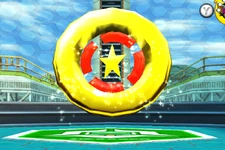
The goal[1][2] is the end point of a playable level in video games. In the Sonic the Hedgehog series, the goal is the final destination of a level. Reaching this destination, and sometimes interacting with whatever devices are there, will end said level.
Overview
In the Sonic series, the goal is the end point of a stage. At that location, the player either has to cross a certain spot, like a finish line, or interact with an object by either passing it, collecting it, touching it, or destroying it. After that, the gameplay in the level automatically ends and the player is taken to the Result screen, where their scores are tallied. This tally takes into account, in most cases, Rings collected, enemies defeated, points gathered, and the time taken to complete the level. Bonuses are also often provided depending on the score achieved or the speed of completion. For example, in Sonic Chaos, the player can get a bonus if they cross the goal at high speed.
Some levels come without a physical goal. Instead, may take the form of a set of conditions that must be satisfied, such as collecting a certain number of Rings, defeating a number of enemies or finding hidden items. Once those conditions are met, the gameplay in the level ends automatically.
List of goal variants
Named goals
Goal Plate
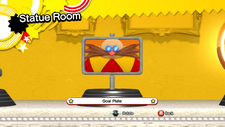
The earliest, yet most well-known goal in the Sonic series is the Goal Plate. They appear at the end of several levels in the games featuring them and passing them will end their level. They take the form of signposts that spin around when passed. When a Goal Plate's spinning is initiated, it usually starts off by displaying Eggman's face, and switches to the player's character's face when it stops spinning. In games like Sonic Chaos and Sonic the Hedgehog Triple Trouble however, the Goal Plate may show one out of several pictures, each one giving a different award when shown, after it finishes its spin.
In the games they appear in, the Goal Plates are not always used for the final Act of a Zone. In such cases, there will be a boss battle instead. Destroying the Capsule that appears after the boss fight will finish the Act.
Goal Ring
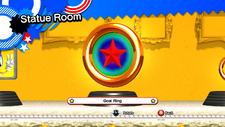
Goal Rings are one of the more modern goals in the Sonic series. They look like the Giant Rings from early Sonic games but serve as the goal at the end of the levels. Just touching a Goal Ring will automatically conclude a level. Though normally containing a star in the center, there are some variations of what is in inside the ring. Some examples of this include Chaos Emeralds in Shadow the Hedgehog, a peace sign once passing through in Sonic Rush, and simply the word "GOAL" in Sonic Adventure 2.
Capsule

The Capsule is a triggerable goal. They take the form of large metallic containers and opening them (which is done by either pushing the button on top of them or breaking them with an attack) in regular levels will conclude their respective level. Also, by opening the Capsules, the player will set whatever was inside free, most commonly Animals. In some games, these Animals can be collected.
Originally, Capsules appeared at the end of final Acts in Zones, but in Sonic Adventure, they were used as the-end-of-stage goals of Action Stages for the first time. Since then, the Capsules have been reused as goals in both their original manner and their manner from Sonic Adventure in several games.
In Sonic Lost World, smaller Capsules can be found in the levels that will not end the level but will reward the player with Animals for opening them.
Chaos Emeralds

Chaos Emeralds are usually the goals of Special Stages or similar stages. Obtaining one of these Emeralds in a Special Stage counts as reaching the goal. In some games, the Chaos Emeralds are usually ready to be collected somewhere in the Special Stages, and the player has to make their way to them. In other games, the player has to fulfil certain requirements before the Emeralds will appear. If those requirements are fulfilled, the player will get the Chaos Emerald automatically; if this is not the case, the player will end the stage automatically empty-handed.
Chaos Emeralds can sometimes be the goal of certain regular stages due to collecting them being part of the game's story. Such was the case in Sonic Labyrinth, where the player can get a Chaos Emerald after defeating a boss to continue with the game. In games such as Sonic Adventure, the Emeralds are found at the end of certain Action Stages. In that game, however, the Chaos Emeralds can only be collected the first time said Action Stages are finished; when replaying the stages, the player will find a Capsule instead.
Super Emeralds
The Super Emeralds are more powerful versions of the Chaos Emeralds, which have only appeared in Sonic 3 & Knuckles so far. In that game, they replace the Chaos Emeralds as the goals of the Sonic & Knuckles Special Stages.
Time Stones
The Time Stones have served as the goals of the Special Stages in Sonic the Hedgehog CD, replacing the Chaos Emeralds in that game.
Goal Balloon
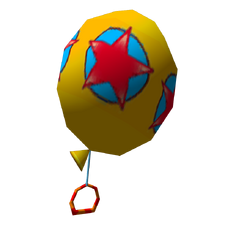
The Goal Balloon is a type of goal that only appears in Sonic Adventure and its re-releases, exclusively to Amy Rose's Action Stages. These goals take the form of yellow, star-emblazoned balloons with a handle hanging from them. Upon grabbing it, the player will have completed the Action Stage and the Goal Balloon will start floating away with Amy hanging onto it.
Froggy
Froggy has served as the goal for Emerald Coast as E-102 Gamma in Sonic Adventure and its re-releases, where he appears in a floating, green orb, like the rest of the Animals. Just touching him with end the Action Stage.
Additionally, in Big's Action Stages in Sonic Adventure, Froggy has to be fished to finish the stages.
Goal Medal
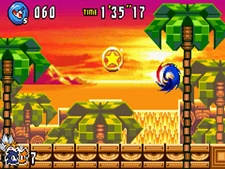
The Goal Medal is a type of goal that only appears in Sonic Advance 3. They are similar to the Goal Rings in terms of design, but smaller. Like the Goal Rings, touching a Goal Medal with automatically conclude the gameplay of a level. These Goal Rings appear at the end of most levels, including boss battles. The Goal Medals will also turn either bronze, silver or gold depending on the player's clear time of the level.
Prison Capsule

The Prison Capsule is a type of goal that only appears in the Wii version and Nintendo DS version of Sonic Colors, along with the remaster Sonic Colors: Ultimate. Resembling Wisp Capsules, they are ground-bound devices that hold numerous White Wisps inside two long tubes. By breaking the Prison Capsule with an attack, the player will conclude the level they are in. However, they are only encountered in a few levels.
Treasure chest

In Sonic Rush Adventure, treasure chests serve as goal for each Act stage in the game. By attacking these objects, they will rotate briefly before opening, upon where they display a sparkling aura. Treasure chests contain different Materials, which the player is rewarded after clearing their Acts, or Medals.
Portal Gate

In Sonic Frontiers, Portal Gates are found at the end of each Cyber Space stage as well being entrance points where Sonic enters the stage each time. Once the player exits the Cyber Space stage, results screen pops in to calculate the player's progression of completing each four missions and getting Ranks of the stage.
Dream Portals
In Sonic Dream Team, Dream Portals are found at the end of every first mission of each act of every stage. Once entered, the stage will end.
Dream Orbs
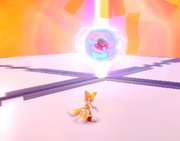
In Sonic Dream Team, Dream Orbs are the goal of several missions. They are usually hidden somewhere in the stage or after an involved platforming section. Once collected, the stage will end.
Unnamed goals
Racing games
In most racing spin-off games, such as Sonic Drift, Sonic R, the Sonic Riders series, the racing Sega All-Stars games, and Team Sonic Racing, the player has to do a certain number of laps (three in most cases) to automatically finish the circuit. Sonic Drift 2 also features some tracks in which the player has to reach a certain spot on the mini-map to finish the race. These spots can be the right side of the screen (such as in Quake Cave) or somewhere else (such as in Milky Way).
Sonic Labyrinth
In the first three Zones of every stage in Sonic Labyrinth, the player has to get three Keys to open a door that says "GOAL" above it. After doing so, they have to locate the door and pass through it to finish the Zone.
Sonic Advance 2

In Sonic Advance 2, there is a unique type of goal gate, which is marked by a pair bars and three colored sectors of limited length behind them.
The player gets 300-800 points based on how fast they pass the threshold. Behind it, the player can brake at any of the colored sectors to earn bonus points by pressing in the opposite direction on ![]() ; the yellow sector grants 800 points, blue 500 points and red 100 points. If the character moves too slow when passing the threshold or decelerates without trying to stop, they will not receive points from the sectors. If the player collects all Special Rings and enters to Special Stage, bonus points are not earned either as the player just keeps running over the field to enter the Special Stage.
; the yellow sector grants 800 points, blue 500 points and red 100 points. If the character moves too slow when passing the threshold or decelerates without trying to stop, they will not receive points from the sectors. If the player collects all Special Rings and enters to Special Stage, bonus points are not earned either as the player just keeps running over the field to enter the Special Stage.
Sonic Forces
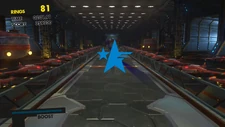
In Sonic Forces, the goal is presented as an animated hologram at the end of the level. It starts out as a red image displaying the Eggman Empire's logo. Once the player goes through it however, the player will have completed the level and the hologram will change into a blue-starred Resistance logo.
Other variations
- Usually defeating the boss in the end of the Zone or in a separate level.
- Missions such as completing the level in a certain amount of time, destroying all the targets, collecting a certain amount of a specific item, or finding a lost Chao.
- Sonic Rush Adventure features goal area[3] at the end of the Sea Stage or Johnny's Race, that the player has to pass through in order to clear it each time.
- The player has to find three Emerald Shards, three keys or three Emeralds. This variation appears in Knuckles and Rouge's levels in Sonic Adventure, Sonic Adventure DX: Director's Cut, Sonic Adventure 2 and Sonic Adventure 2: Battle.
- A similar variant appears when collecting all six Dream Orb Shards in Sonic Dream Team.
Ranking
Starting in Sonic Adventure 2, the player is ranked on performance in a stage, but no actual bonuses were granted until one had completed everything with an "A" or "S" Rank, depending on the game.
In Sonic the Hedgehog (2006), additional Rings were rewarded depending on performance. The higher the rank, the more rings were obtained.
In the Sonic Storybook games, there are unique methods of ranking. The medal ranking system in Sonic Advance 3 was used in Sonic and the Secret Rings with three ranks: gold (highest), silver (2nd highest) and bronze (2nd lowest), introducing the "no medal" rank as lowest. In Sonic and the Black Knight, performance in a level is ranked by stars, where ★★★★★ is the highest and ★☆☆☆☆ is the lowest (though in some rare cases, one could get ☆☆☆☆☆ in a similar fashion to ★☆☆☆☆).
References
- ↑ Sonic Advance 2 (Game Boy Advance) United States instruction booklet, pg. 17.
- ↑ Sonic Forces (PC) English digital instruction booklet, "Playing the Game."
- ↑ Sonic Rush Adventure (Nintendo DS) United States instruction booklet, pg. 19.